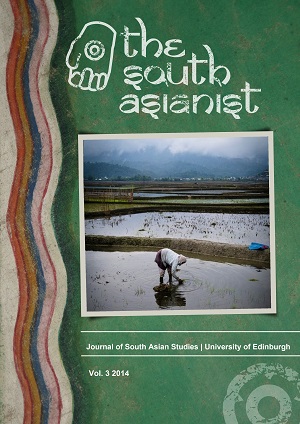To what extent was 1857 an example of colonial genocide? A study of colonial violence during the Indian Uprising of 1857-59
Abstract
The 1857-59 Indian Uprising was a cataclysmic event in the history of the British Empire in India and would witness monumental and shocking scenes of violence on both sides of the conflict. The Uprising has become something much debated and discussed within Indian and British history, and an exploration of the fundamental brutality of the conflict, albeit in this case on the British side, is an important element of better understanding such an important historical event. This article therefore explores the British Army's use of violence against Indian Sepoys and ordinary civilians during the Uprising and works to explore as to whether this approached something akin to a genocide, as has previously been suggested.
Downloads
References
Primary Sources:
Charles Griffiths, A Narrative of the Siege of Delhi (London: John Murray) 1910
Field-Marshal Earl Roberts, Letters Written During the Indian Mutiny (London: Macmillan) 1924
Henry Metcalfe, The Chronicle of Private Henry Metcalfe (London: Cassell) 1953
General Neill’s orders to Major Renaud in John William Kaye, Lives of Indian Officers: illustrative of the history of the civil and military services of India (London: A. Strahan) 1867
General Neill’s personal letter dated August 1st 1857 in The London Times, Monday, Sep 28, 1857; pg. 8; Issue 22797 from The Times Digital Archive Online
Field-Marshal Earl Roberts, Letters Written During the Indian Mutiny (London: Macmillan) 1924
Julia Haldane, The Story of Our Escape from Delhi in 1857 (Agra: Brown and Sons)
Reginald Wilberforce, Unrecorded Chapter of the Indian Mutiny: being personal reminisces of Reginald G. Wilberforce compiled from a diary and letters written on the spot, with illustrations (London: John Murray) 1894
Selections from the letters, despatches and other state papers from the Government of India, 1857-58 (Calcutta: Military Dept. Press) 1893
Thomas Lowe, Central India During the Rebellion of 1857 and 1858 (London: Longman, Green & Co.) 1860
Thomas Marshman, Memoirs of Major General Sir Henry Havelock (London: Longman, Green & Co.) 1860
Torture Commission Report in Investigation of Tortures in India in On Colonialism (Moscow: Foreign Languages Publishing House) 1960
The Times, Thursday, Sep 17, 1857; pg. 9; Issue 22788 from The Times Digital Archive Online
General Neill’s personal letter dated August 1st 1857 in The London Times, Monday, Sep 28, 1857; pg. 8; Issue 22797
William Forbes Mitchell, Reminisces of the Great Mutiny, 1857-59 (New Delhi: Asian Education Services) 2002
William Russell, My Indian Mutiny Diary (New York: Klaus Reprint Co) 1957
Secondary Sources:
Adam Jones, Genocide: A Comprehensive Introduction (London: Routledge) 2006
Amaresh Misra in The Guardian, Friday 24 August 2007 http://www.guardian.co.uk/world/2007/aug/24/india.randeepramesh
Anna Bourke, An Intimate History of Killing: face to face killing in twentieth century warfare (London: Granta Books) 1999
Bernard S. Cohn, ‘Representing Authority in Victorian India’ in The Invention of Tradition, Eric Hobsbawm and Terence Ranger (eds.) (Cambridge: Cambridge University Press) 1992
Caroline Elkins, Britain’s Gulag: The brutal end of Empire (London: Jonathon Cape) 2005
Crispin Bates, Subalterns and Raj: South Asia Since 1600 (London: Routledge) 2007
Crispin Bates and Gavin Rand, Mutiny at the Margins: New Perspectives on the Indian Uprising of 1857: Volume 4: Military Aspects of the Indian Uprising (Sage Publications: 2013)
David Andersen, Histories of the Hanged: Britain’s dirty war in Kenya and the end of empire (London: Weidenfeld and Nicholson) 2005
Denis Judd, The British Imperial Experience, from 1765 to the present (London: Harper Collins) 1996
Donald Bloxham, The Final Solution: A Genocide (Oxford; New York: Oxford University Press) 2009
Elizabeth Kolsky, Colonial Justice in British India (Cambridge: Cambridge University Press) 2010
Gavin Rand ‘Martial races’ and ‘imperial subjects’: violence and governance in colonial India, 1857–1914. European Review of History 2006, 13 (1), pp. 1-20
Hannah Arendt, The Origins of Totalitarianism (London: World Publishing Company) 1961
Hannah Arendt, On Violence (New York: Harcourt, Brace Jovanovich) 1970
John William Kaye, Lives of Indian Officers: illustrative of the history of the civil and military services of India (London: A. Strahan) 1867
John Newsinger, The Blood Never Dried: A People’s History of the British Empire (London: Bookmarks) 2006
Karl Marx & Friedrich Engels, Investigation of Tortures in India in On Colonialism (Moscow: Foreign Languages Publishing House) 1960
Martin Shaw, What is Genocide? (Cambridge: Polity Press) 2007
Michel Foucault, Discipline and Punish (London: Allen Lane) 1977
Nigel Collett, The Butcher of Amritsar: General Reginald Dyer (London: Hambledon & London) 2005
Otto Triffterer (2001). ‘Genocide, Its Particular Intent to Destroy in Whole or in Part the Group as Such’ Leiden Journal of International Law, 14, pp. 399408
Richard Gott, Britain’s Empire: Resistance, Repression and Revolt (London: Verso Books)
Rudrangshu Mukherjee, “Satan Let Loose Upon the Earth” The Kanpur Massacres in India in the Revolt of 1857’ Past and Present (1990) 128(1): 92-116
Samuel Totten & Paul R. Bartrop (eds.), The Genocide Studies Reader (London: Routledge) 2009
Sashi Bhusan Chaudhuri, Theories of the Indian Mutiny, 1857-59: a study of the views of an eminent historian on the subject (Calcutta: World Press) 1965
Sabyasachi Bhattacharya (eds.) Rethinking 1857 (New Delhi: Orient Longman) 2007
William A. Schabas (2001). ‘The Jelisic Case and the Mens Rea of the Crime of Genocide’ Leiden Journal of International Law, 14, pp. 125139




